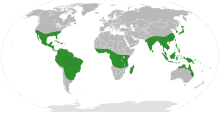Simaroubaceae
| Simaroubaceae | |
|---|---|

| |
| Ailanthus altissima | |
| Scientific classification | |
| Kingdom: | Plantae |
| Clade: | Tracheophytes |
| Clade: | Angiosperms |
| Clade: | Eudicots |
| Clade: | Rosids |
| Order: | Sapindales |
| Family: | Simaroubaceae DC.[1] |
| Genera | |
|
See text | |

| |
| Distribution of the family Simaroubaceae. | |
| Synonyms | |
| |
The Simaroubaceae are a small, mostly tropical, family in the order Sapindales. In recent decades, it has been subject to much taxonomic debate, with several small families being split off. A molecular phylogeny of the family was published in 2007, greatly clarifying relationships within the family.[2] Together with chemical characteristics such as the occurrence of petroselinic acid in Picrasma,[3] in contrast to other members of the family such as Ailanthus,[4] this indicates the existence of a subgroup in the family with Picrasma, Holacantha, and Castela.
The best-known species is the temperate Chinese tree-of-heaven Ailanthus altissima, which has become a cosmopolitan weed tree of urban areas[5] and wildlands.[6]
Well-known genera in the family include the tropical Quassia and Simarouba.
Genera
[edit]20 genera are accepted:[7]
- Ailanthus Desf.
- †Ailanthophyllum Dawson
- Brucea J.F.Mill.
- Castela Turpin
- Eurycoma Jack
- Gymnostemon Aubrév. & Pellegr.
- Hannoa Planch.
- Homalolepis Turcz.
- Iridosma Aubrév. & Pellegr.
- Leitneria Chapm.
- Nothospondias Engl.
- Odyendea Pierre ex Engl.
- Perriera Courchet
- Picrasma Blume
- Picrolemma Hook.f.
- Pierreodendron Engl.
- Quassia L.
- Samadera Gaertn.
- Simaba Aubl.
- Simarouba Aubl.
- Soulamea Lam.[8]
Excluded genera
[edit]- Allantospermum Forman → Ixonanthaceae
- Alvaradoa Liebm. → Picramniaceae
- Desbordesia Pierre ex Tiegh. → Irvingiaceae
- Harrisonia R.Br. ex A.Juss. → Rutaceae
- Irvingia Hook.f. → Irvingiaceae
- Kirkia Oliv. → Kirkiaceae
- Klainedoxa Pierre ex Engl. → Irvingiaceae
- Picramnia Sw. → Picramniaceae
- Recchia Sessé & Moc. ex DC. → Surianaceae[9]
References
[edit]- ^ a b "Family: Simaroubaceae DC., nom. cons". Germplasm Resources Information Network. United States Department of Agriculture. 2003-01-17. Retrieved 2011-04-19.
- ^ Clayton, Joshua W.; Edwino S. Fernando; Pamela S. Soltis; Douglas E. Soltis (2007). "Molecular phylogeny of the tree-of-heaven family (Simaroubaceae) based on chloroplast and nuclear markers". International Journal of Plant Sciences. 168 (9): 1325–1339. doi:10.1086/521796. S2CID 86016778.
- ^ Tsujimoto, M.; Koyanagi, H. (May 1933). "On Nikagi Oil". Bull. Chem. Soc. Jpn. 8 (5): 161–167.
{{cite journal}}: CS1 maint: date and year (link) - ^ T. Stuhlfauth; H. Fock; H. Huber; K. Klug (1985). "The distribution of fatty acids including petroselinic and tariric acids in the fruit and seed oils of the Pittosporaceae, Araliaceae, Umbelliferae, Simarubaceae and Rutaceae". Biochemical Systematics and Ecology. 13: 447–453. doi:10.1016/0305-1978(85)90091-2.
- ^ Elizabeth Pan; Nina Bassuk (March 1986). "Establishment and Distribution of Ailanthus altissima in the Urban Environment" (PDF). J. Environ. Hort. 4 (1): 1–4.
- ^ Knapp, Liza B; Canham, Charles D (2000). "Invasion of an Old-Growth Forest in New York by Ailanthus altissima: Sapling Growth and Recruitment in Canopy Gaps". Journal of the Torrey Botanical Society. 127 (4): 307. doi:10.2307/3088649. JSTOR 3088649.
- ^ "Simaroubaceae DC". Plants of the World Online. Retrieved 16 December 2023.
- ^ "GRIN Genera of Simaroubaceae". Germplasm Resources Information Network. United States Department of Agriculture. Retrieved 2011-04-19.
- ^ "GRIN genera sometimes placed in Simaroubaceae". Germplasm Resources Information Network. United States Department of Agriculture. Retrieved 2011-04-19.
External links
[edit]![]() Media related to Simaroubaceae at Wikimedia Commons
Media related to Simaroubaceae at Wikimedia Commons
![]() Data related to Simaroubaceae at Wikispecies
Data related to Simaroubaceae at Wikispecies
